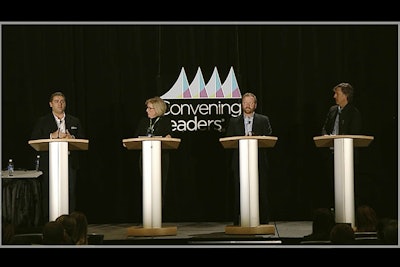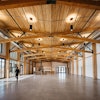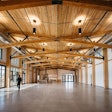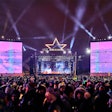
More than 4,000 meeting industry professionals gathered at the Vancouver Convention Centre January 10 to 13 for the Professional Convention Management Association's Convening Leaders conference. The program focused on event technology, meeting design, and business event strategy. In a session January 10, marketers from Lululemon Athletica, Maersk Group, Lanyon, and the American Institute of Architects shared details of how they are using face-to-face experiences to drive brand engagement and how they evaluate the success of those events.
The role of events
“Even on the internal side, [events] are really critical for our ability to mobilize the brand. Within the North American market over the last two years, it’s been one of the most challenging times in shipping and transportation due to a number of factors … you start to see the real value of how you leverage an event to rally the troops. We had our North American sales forum at the beginning of 2015, and we did work around experience design to mobilize the brand and to invigorate our sales teams. We ended up having our best year in the history of the organization this year. I can’t say it has everything to do with the event, but if you think of our sales team as the number one deliverer of the brand, I feel like the event was something that really catalyzed and mobilized and communicated our brand in a powerful way.”
Timothy Simpson, head of integrated marketing, Maersk Group
“The biggest event we do as a company happens every August, and it’s a half marathon. It sells out in under 30 minutes. … Our thought is events help people experience the Lululemon brand. We create those events based on our guest feedback. We just ask people what they want, we listen, and then we deliver it to them with as much quality and as much attention to detail as we can. Always with a focus on fun. That would be the biggest event. Then once or twice a week in almost all of our stores, there is some type of event. We give the stores budgets, and we empower them to do something. Events for us, both large and small, are the way our guests can experience the brand. But the most important thing is actually creating something the guest wants versus us saying, 'This is what we want so we’ll create it for you guys and hope you come.'”
Eric Peterson, senior vice president of global brand programs, Lululemon Athletica
“Our events embody our brand. We have a couple of challenges. Architects are viewed as kind of cool and hip … and they’re so creative … but A.I.A. is a 160-year-old organization. We have a reputation as being respectable and admired and powerful but also too stuck in the past and too focused on tradition and pomp and circumstance. Our convention embodies who the organization is, it doesn’t necessarily reflect who we represent. … That’s been the biggest hurdle for us—trying to get people in the organization to get behind the need to transform the convention.”
Kathy Compton, senior vice president of strategic communications, marketing, and convention, American Institute of Architects
The value of data and metrics
“There is nothing that will drive executive alignment around events better than metrics and results. I did a difficult thing when I came on. We cut a number of trade shows because I was unable to tell you what we got in return for it. So we focused on the ones we could see a return from and started to build backup. I urge you to spend as much of your time as you can to find those metrics. It can be a yawner, but fundamentally for me the metrics are what will feed our ability to continue to do events, which we all know emotionally and conceptually and anecdotally are a great way to do business. … In the B-to-B sphere, research shows we spend approximately 24 percent of our marketing budget on meetings events and webinars compared to about 13 percent on digital marketing. We can measure everything when it comes to digital marketing—cost per click, cost per lead—we can see everything. And we are spending significantly more money on events, so the time has come for us to be able to measure that activity, not potentially as well as digital yet, but we need to be able to look at the metrics in a similar way we look at digital marketing. Because we’re spending a lot of money on this and the metrics have to follow.”
Anthony Miller, C.M.O., Lanyon
“I’ve been on that journey of creating something from nothing. So when we came to our management and said we want to do this events program, we want to focus in on getting you in front of the customers more, at first it was difficult. But over time they started to see the value, because we got really good at measuring it and the impact it could have. For example, within our North American organization we were able to show that customers who come to our customer events program, their satisfaction and loyalty is a whole point higher than those who don’t … and they are delivering on average 8 percent more volume to our business and on average are somewhere between 100 to 200 dollars more on the rate they give us for every container we ship. You can’t deny those numbers. It’s not to say it’s all because of the event, but when you bring that to a senior leader and you say here’s the tangible result, they quickly say I’m in. And that’s given us the license to create better and more interesting experiences through our events.”
Timothy Simpson
“We do spend a great deal of time providing metrics to our board and our leadership. It’s interesting because they really are very interested in word of mouth and conversation that takes place after the convention. So while the metrics are interesting and important, they are really very interested in what their colleagues have to say when they report back to them. So that’s just as important. We are trying to get better at metrics and to find more metrics to report out so they come to expect to hear that information from us.”
Kathy Compton
Designing the attendee experience
“One of our filters has always been that whatever we do has to create a conversation. … We don’t do it unless somebody is going to talk about it. We like the element of surprising our guests. So we want to give them a level of quality, but we want to educate them on something or surprise them with something they’d never expect. Those are things that when you leave an event from Lululemon we want you to tell somebody. … Time is the most important thing for us, and we value our guests’ time at $200 an hour. … So then you put yourself in the guest’s shoes. You have to park and run into this store. You need to get in and out very quickly. It goes for any events too. If there’s a time and place for just sitting and listening to music, is it worth it? That measure of $200 an hour really drives people.”
Eric Peterson
“The R.O.I. for the attendee is so much more important than it used to be because there’s so many ways to get information today. Your decision to leave your family, leave your workplace, get on a plane, and go to an event is now such a bigger decision for you. The return you get from it, your expectation is so much higher. I read every single comment we got from our customer conference. Every word was valuable to us. Continuing to focus on the attendee R.O.I. will be key as we move forward.”
Anthony Miller
“We have traditionally done it from a one-size-fits-all perspective: architects are one tribe. We’ve come to realize they are many tribes. We’ve built a convention around what we think they want or we think they should have or need, and what we want to do is build a live event around what they want to experience. We are not there yet but we are working hard to get there.”
Kathy Compton



















